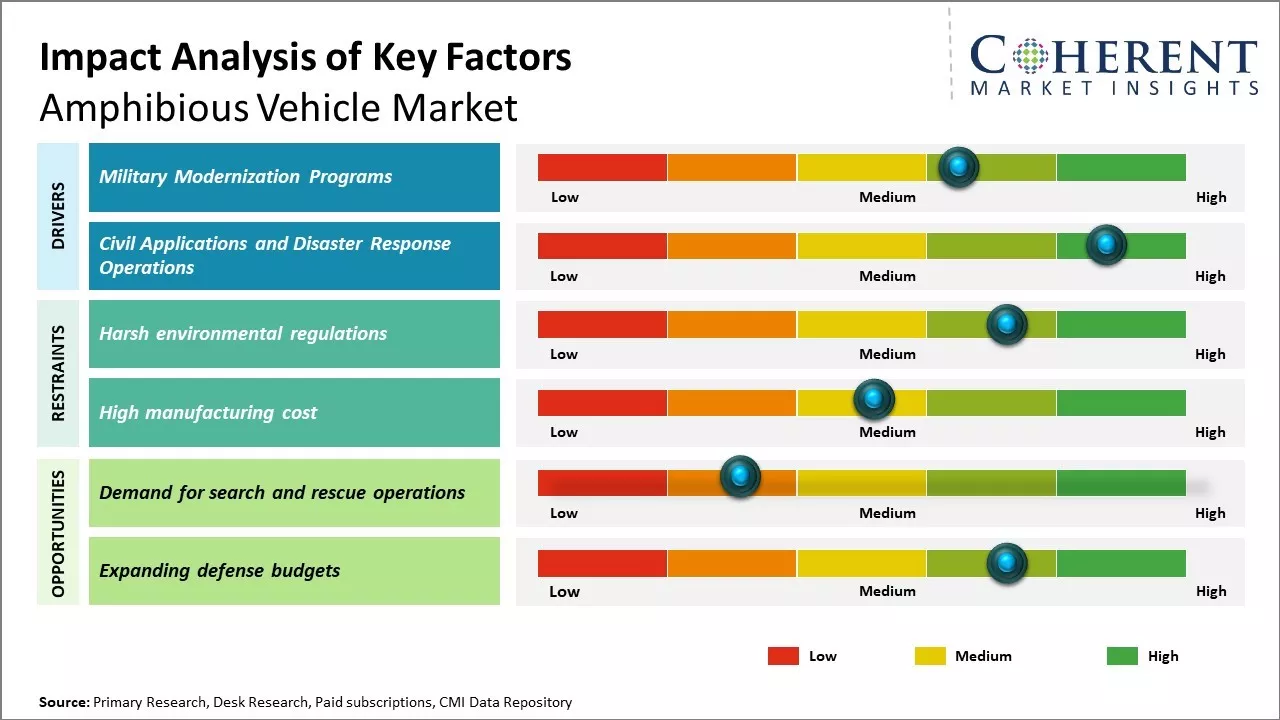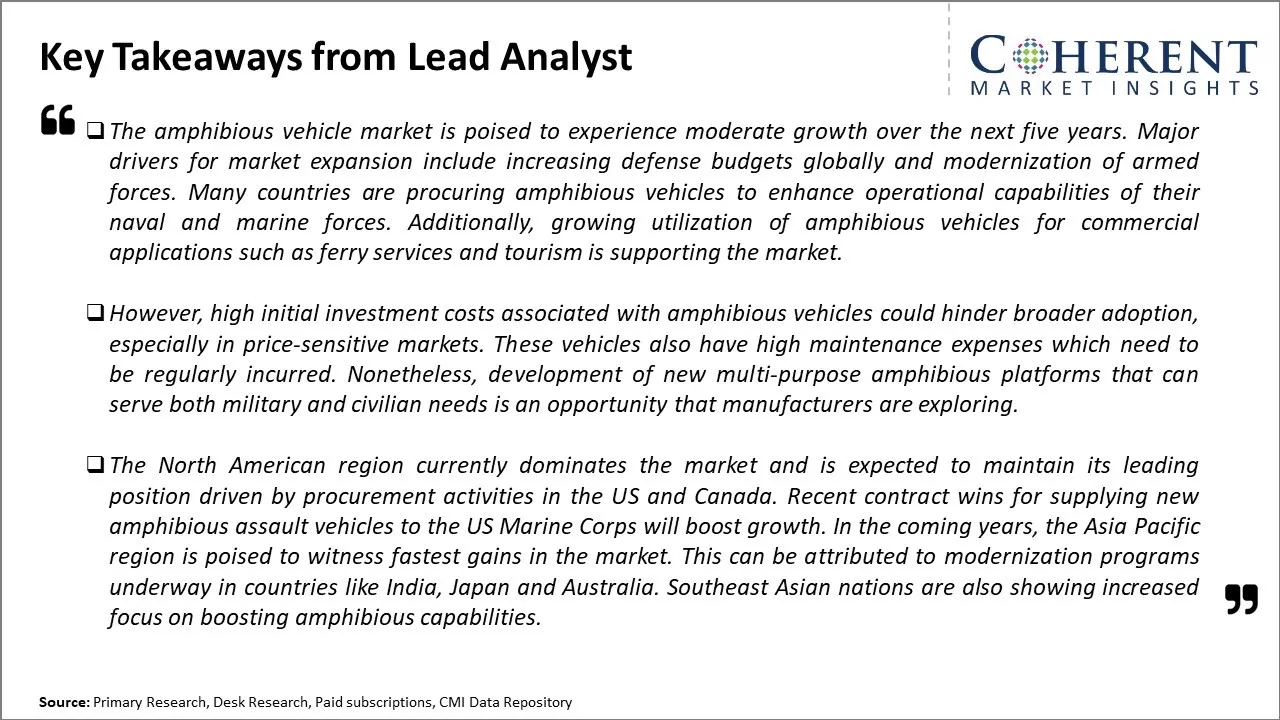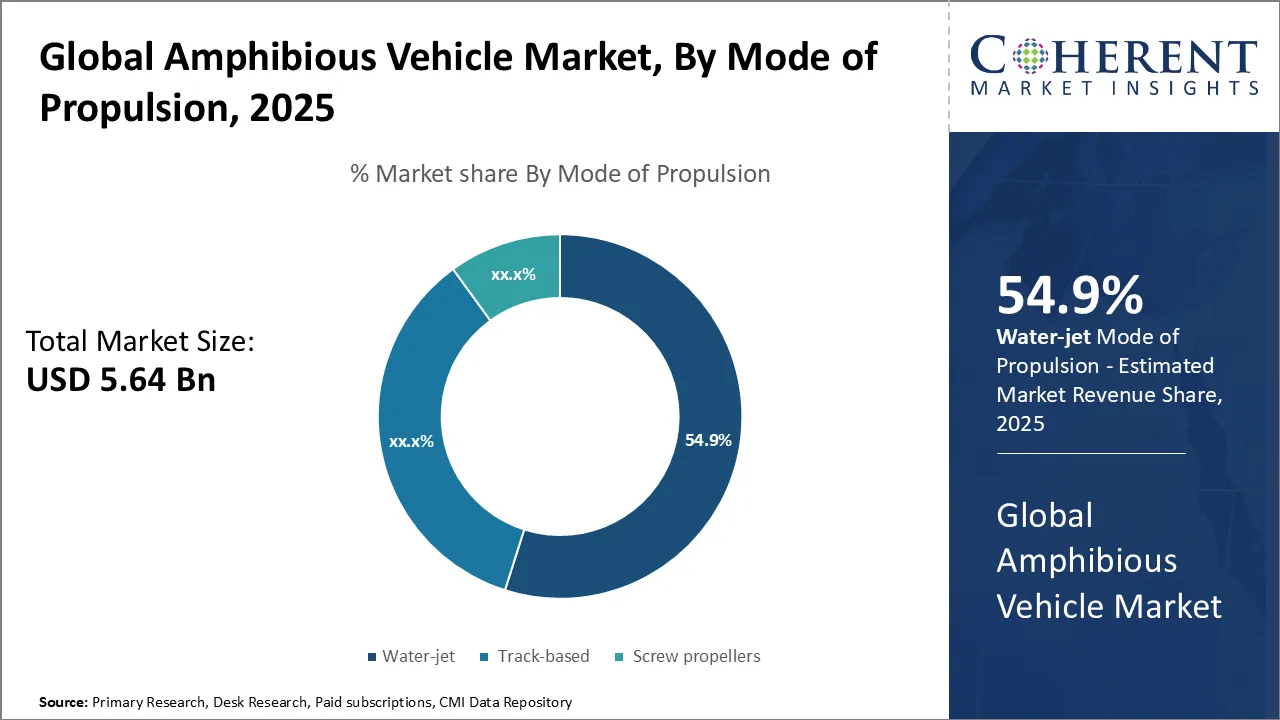The amphibious vehicle market is estimated to be valued at US$ 5.64 Bn in 2025 and is expected to reach US$ 11.80 Bn by 2032, growing at a compound annual growth rate (CAGR) of 11.1% from 2025 to 2032. Amphibious vehicles allow for transportation on both land and water, providing versatility across diverse terrains for both commercial and military applications.

Discover market dynamics shaping the industry: Request sample copy
The amphibious vehicle market is driven by growing defense modernization programs worldwide. Militaries are increasingly procuring advanced amphibious vehicles to enhance mobility and operational reach of armed forces. Meanwhile, increased utilization of amphibious vehicles for commercial activities such as adventure tourism, coastal surveillance, and fishing is also supporting the market growth. However, high maintenance costs of amphibious vehicles could limit market expansion.
Market Drivers: Military Modernization Programs
Many countries across the globe are actively investing in modernizing their military forces. As defense budgets are on the rise, nations are looking at procuring new and advanced platforms to strengthen their strategic and tactical capabilities. Amphibious vehicles play a crucial role in naval and marine warfare operations. Their ability to maneuver across land and water enables quick deployment of troops and makes territorial invasions relatively easy. Recognizing their importance, military leaders are retiring old fleets of armored vehicles and procuring new generations of advanced amphibious assault crafts. For example, the U.S. Marine Corps has initiated the Amphibious Combat Vehicle program with plans to replace its ageing fleet of AAV7s. Several European nations are also bulk procurement programs for 8x8 or 6x6 wheeled amphibious armored personnel carriers. As military budgets grow and more countries invest in maritime expeditionary capabilities, the demand for high speed and highly protected amphibious platforms is likely to rise steadily in the coming years. This will prove beneficial for manufacturers in the amphibious vehicles domain.

Get actionable strategies to beat competition: Request sample copy
Government policies to promote electric mobilityMany governments are taking initiatives to switch commuting from petrol or diesel vehicles to more sustainable electric vehicles. These are pushing adoption of electric vehicles through various policies and schemes. For instance, some countries offer purchase incentives on electric Tuk-Tuks to encourage drivers to go electric. The incentives can make electric tuk-tuks a more affordable option as compared to internal combustion engine models. Some nations also provide subsidies on purchasing charging infrastructure for owners of electric tuk-tuks. This helps address range anxiety among drivers and boosts the adoption of electric variants.
Many cities and local authorities in Asia Pacific are also formulating policies to restrict or ban conventionally-fueled tuk-tuks in the near future. These want to lower air pollution levels and carbon emissions from transport sector. Some major cities have announced that it will allow registration of only electric tuk-tuks from a certain future date. While this puts pressure on the existing drivers, it also creates a huge business prospect for electric tuk-tuks. Manufacturers are aiming to cater to this impending demand. The governments are also coming up with specific schemes to reskill drivers of traditional Tuk-Tuks so that these can smoothly switch to electric vehicles. With supportive regulations, a controlled transition seems possible which will accelerate the electric tuk-tuks market growth.

To learn more about this report, Request sample copy
Market Challenges: Harsh environmental regulationsHarsh environmental regulations also increase vehicle development costs. Amphibious vehicles must be able to traverse both land and water, making them more complex and expensive to design and manufacture than conventional vehicles. Off-road and waterside performance demands place further engineering requirements on amphibious vehicles. Additionally, with fewer military applications, consumer and commercial amphibious vehicle markets have yet to gain significant momentum.
Market Opportunities: Demand for search and rescue operations
As climate change leads to more extreme weather, amphibious vehicles could see increasing demand for search and rescue operations. Recreational and tourism applications of amphibious vehicles continue to emerge as novelty and specialist niche markets.

Discover high revenue pocket segments and roadmap to it: Request sample copy
Insights, By Mode of Propulsion- Superior Traction Drives Track-based Segment DominanceIn terms of mode of propulsion, the track-based segment contributes the highest share 54.9% in 2025 of the amphibious vehicle market owing to its ability to maximize traction in diverse terrain conditions. Tracks provide unmatched traction on land, allowing track-based amphibious vehicles to traverse rugged environments impassable by wheeled counterparts. This is invaluable for applications ranging from border patrol and emergency response to construction and mining. Tracks distribute vehicle weight over a large ground contact area, enabling travel over soft ground, mud, sand, and lightly Vegetated areas that would bog down wheeled models.
Tracks also impart excellent flotation in water, helping to support a vehicle's weight and generate thrust for locomotion. Their continuous band design forms a barrier that prevents water from penetrating the tracks and hampering mechanical components when submerged. Track propulsion ensures amphibious vehicles can smoothly transition between land and water modes without any delay or need for manual configuration changes. Tracks enable vehicles to "swim" simply by engaging hydrojets, propellers or other marine propulsion while maintaining full steering and stability in the water.
Compared to wheel and hydrojet alternatives, track systems have lower maintenance needs and longer usable lifespan. Their modular, replaceable link, and roller assembly design means tracks can continue functioning even if individual parts sustain damage from harsh conditions. Minimal moving parts translate to higher reliability in remote and austere environments compared to complex hydrojet pump and steering systems. Affordability has also increased with rising standardization and mass production of tracks tailored for amphibious applications. Overall, tracks empower seamless amphibious capability in challenging settings, underpinning their dominant position.
Insights, By Application- Surveillance Needs Drive Excavation Segment Leadership
In terms of application, the excavation segment holds the leading position in the amphibious vehicle market owing 33% in 2025 to unique surveillance and monitoring needs in the mining and construction industries. Amphibious excavators enable on-site personnel to perform visual inspections, equipment checks and geological surveys that would otherwise require lengthy land/water transportation or additional watercraft. They allow assessing, scoping and troubleshooting jobs that interface between land and bodies of water with just one mobile platform.
Amphibious excavators facilitate dredging, land reclamation, and drainage projects that necessitate continuous movement between land and shallow water. Their ability to excavate on both mediums seamlessly boosts productivity by eliminating downtime and doubling the usable workspace area. This is invaluable for projects situated along coastlines, rivers, lakes, and other wetlands. Amphibious capability also supports environmental monitoring and restoration efforts in ecologically sensitive wetlands that are difficult to access.
Further, amphibious excavators provide a safer alternative to working in and around water compared to conventional land equipment or water vessels alone. They eliminate risks from operating heavy machinery near water's edge or transferring staff/materials between land and boat. Personnel enjoy the added visibility and stability of an enclosed, self-contained work platform compared to smaller watercraft. Overall, the unique access and productivity advantages amphibious excavators provide surveillance and monitoring intensify needs from the mining, construction, environmental, and infra sectors, cementing their leadership.
Insights By, End User- Commercial Applications Spur the Highest Adoption
In terms of end user, the commercial segment generates the highest demand in the amphibious vehicle market owing 69.9% in 2025 to diverse new applications emerging across market. Commercial users ranging from tour/water sport operators to construction contractors and dredging firms recognize amphibious vehicles' potential to boost operations, services, and revenues. Their multipurpose land-water capability unlocks wholly new business prospects and working methodologies compared to traditional vehicles and watercraft.
Growing interest in recreational activities like swamp touring, river cruising, and wildlife ecotourism has spurred niche commercial amphibious fleets. These provide safe, stable, and environment-friendly tours into shallow natural areas inaccessible by other means. In construction, amphibious vehicles facilitate new techniques like floating modular building and off-shore site preparation from land to short distances at sea without large marine equipment.
Municipalities increasingly deploy amphibious vehicles for functions like garbage collection from coastal communities and amphibious response units for coastal search/rescue, firefighting, and policing. Commercial dredging fleets also utilize amphibious excavators for surveys, seabed mining, and underwater infrastructure development close to shore.

Need a Different Region or Segment? Customize now
North America has been the dominant region with 48.9%in 2025 in the global amphibious vehicle market for many years. The U.S. accounts for the largest share primarily due to high demand from the defense sector. Major American defense contractors such as BAE Systems, Lockheed Martin, and Textron have established prominent manufacturing bases in the region to cater to the growing needs of the U.S. military. In addition, the presence of advanced military infrastructure and higher defense expenditures compared to other nations have created sustained opportunities over the years. The regional market is also fueled by the ongoing military modernization programs, especially the ones focusing on amphibious combat vehicles and expeditionary fighting vehicles.
The Asia Pacific region has emerged as the fastest growing market for amphibious vehicles in recent times. Countries like China and India are aggressively pursuing indigenous development as well as imports to modernize their armed forces. This has provided the much needed momentum. China, being a global defense powerhouse, has actively pursued amphibious warfare capabilities to strengthen naval expeditionary operations. Several state-owned shipbuilding majors have introduced new amphibious assault vehicles as part of the country's amphibious integration plans. Other Southeast Asian nations are also acquiring such systems to boost coastal surveillance and maritime security capabilities. Coupled with ongoing defense reforms and rising maritime conflicts in the wider Indo-Pacific region, the demand environment remains highly conducive for sustaining the growth momentum over the long term. The regional market is also gaining from supportive policy frameworks and incentivizing indigenous manufacturing under the 'Make in India' and 'China Marine' programs.
Global Amphibious Vehicle Market Report Coverage
| Report Coverage | Details | ||
|---|---|---|---|
| Base Year: | 2024 | Market Size in 2025: | USD 5.64 Bn |
| Historical Data for: | 2020 To 2024 | Forecast Period: | 2025 To 2032 |
| Forecast Period 2025 to 2032 CAGR: | 11.1% | 2032 Value Projection: | USD 11.80 Bn |
| Geographies covered: |
|
||
| Segments covered: |
|
||
| Companies covered: |
Hitachi Construction Machinery Co. Ltd, BAE System, Science Applications International Corporation (SAIC), Wetland Equipment Company, General Dynamics Corporation, Lockheed Martin Corporation, Wilco Manufacturing, L.L.C, EIK Engineering Sdn Bhd, Marsh Buggies Incorporated, Rheinmetall AG, EIK Engineering Sdn. Bhd., and Griffon Hoverwork Ltd. (GHL) |
||
| Growth Drivers: |
|
||
| Restraints & Challenges: |
|
||
Uncover macros and micros vetted on 75+ parameters: Get instant access to report
Share
Share
About Author
Gautam Mahajan is a Research Consultant with 5+ years of experience in market research and consulting. He excels in analyzing market engineering, market trends, competitive landscapes, and technological developments. He specializes in both primary and secondary research, as well as strategic consulting across diverse sectors.
Missing comfort of reading report in your local language? Find your preferred language :
Transform your Strategy with Exclusive Trending Reports :
Frequently Asked Questions
Joining thousands of companies around the world committed to making the Excellent Business Solutions.
View All Our Clients
US Reciprocal Tax Impact Analysis On Global Amphibious Vehicle Market
Stay updated on tariff changes with expert insights and timely information